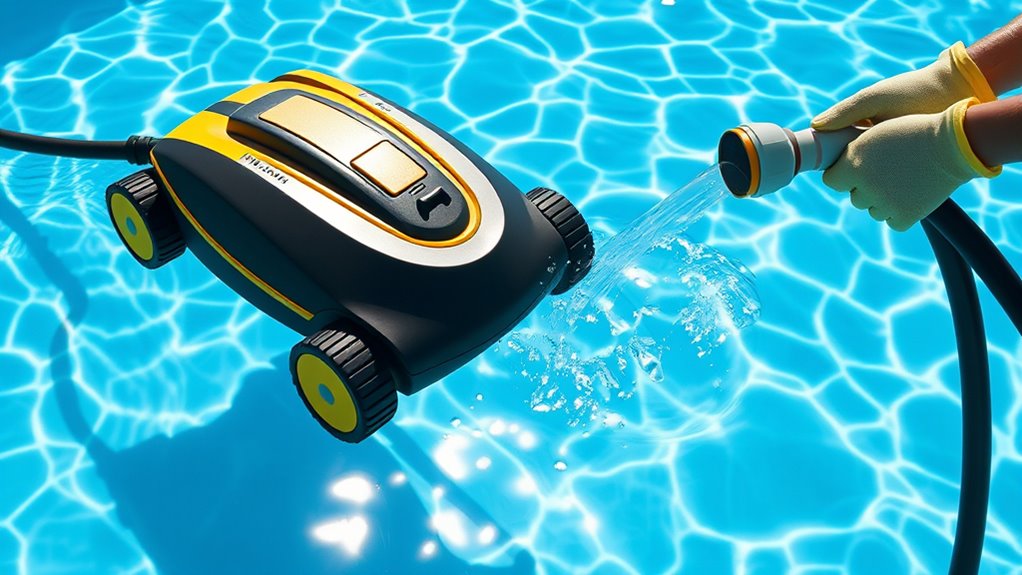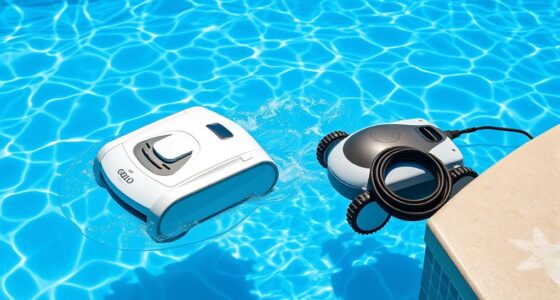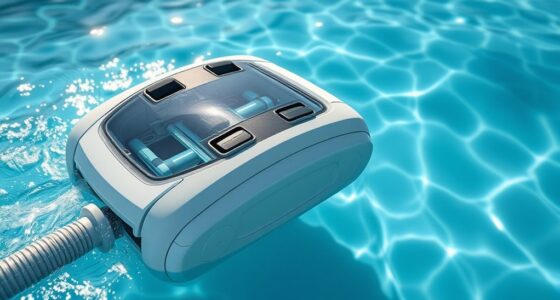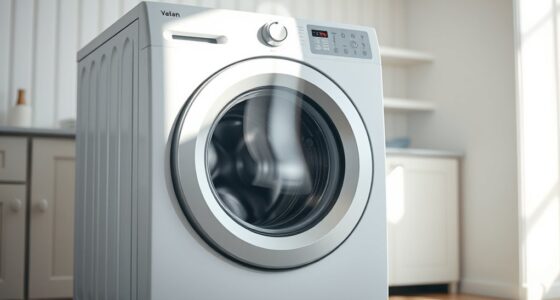To maintain your pressure pool cleaner, regularly check and clean the filter, inspecting for damage and replacing worn parts. Examine the hose for cracks, leaks, or kinks, and ensure all fittings are tight and free of obstructions. Rinse the cleaner’s body and wheels after heavy use to prevent dirt buildup, and inspect brushes and wheels for wear. Keep electrical connections secure and clean. Following these steps helps extend your cleaner’s lifespan and keeps it working efficiently—keep going to learn more tips.
Key Takeaways
- Regularly inspect and clean the filter cartridge or bag to ensure optimal water flow and performance.
- Examine hoses for cracks, leaks, and kinks; tighten fittings and replace damaged sections as needed.
- Rinse the cleaner’s body, wheels, and brushes after heavy use to prevent dirt buildup and wear.
- Check electrical connections and replace worn brushes or damaged components promptly to avoid malfunctions.
- Store the cleaner in a cool, dry place during the off-season after thorough cleaning and drying.
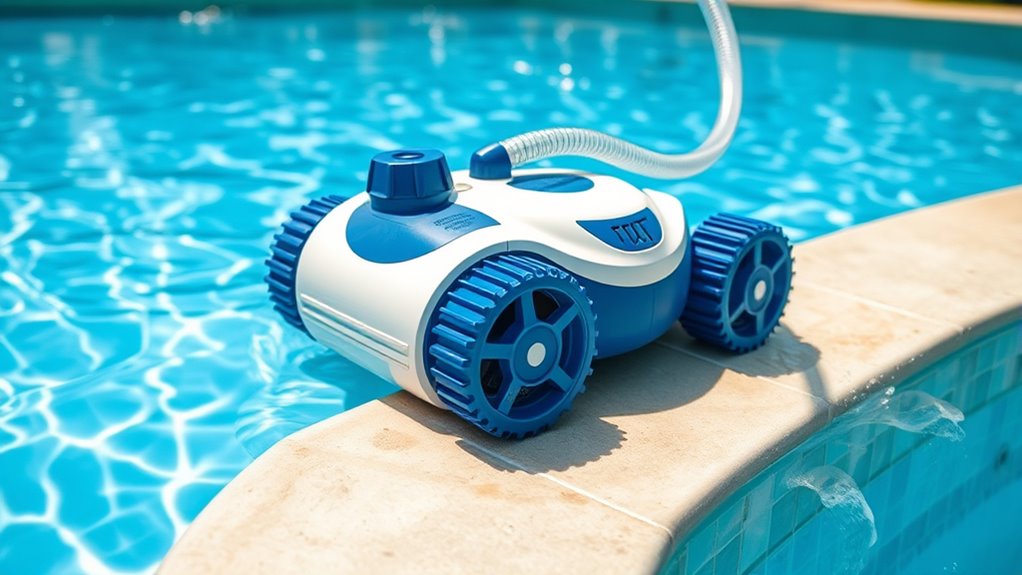
Keeping your pressure pool cleaner in top shape guarantees it runs efficiently and lasts longer. One of the most important aspects of maintenance is ensuring the filter stays clean and functioning properly. Regular filter maintenance prevents debris from clogging the system, which can reduce suction power and strain the cleaner’s motor. To do this, you should check the filter often, especially after heavy use or when you notice the cleaner isn’t performing as well. Remove the filter cartridge or bag, and rinse it thoroughly with a garden hose to clear out dirt and debris. If the filter appears worn or damaged, replace it promptly to maintain ideal cleaning performance. Keeping the filter clean not only improves the efficiency of your pressure cleaner but also extends its lifespan. Additionally, filter calibration can help ensure your cleaner operates at optimal pressure levels for thorough cleaning. Proper calibration can also prevent unnecessary wear and tear on the system components.
Hose inspection is equally critical in maintaining your pressure pool cleaner. Regularly examine the entire length of the hose for cracks, leaks, or signs of wear. Damaged hoses can lead to loss of pressure, reducing the cleaner’s ability to effectively scrub your pool surfaces. When inspecting, look for any loose connections or kinks that could restrict water flow. Tighten or replace any fittings that are loose or damaged. Kinks and leaks can also cause the cleaner to malfunction or become stuck, so ensure the hose remains flexible and free of obstructions. Proper hose inspection and maintenance help prevent breakdowns and ensure consistent pressure, which is essential for thorough cleaning. Additionally, staying informed about latest machine learning advancements can help you troubleshoot or optimize your pool equipment with smart technology features. Regularly cleaning and inspecting the cleaner’s brushes and wheels will also contribute to better performance and longevity of the device.
Beyond filter maintenance and hose inspection, it’s good practice to keep the entire cleaner free of debris and check for any blockages that might hinder movement. Rinse the cleaner’s body and wheels regularly, especially after heavy use, to prevent the buildup of dirt or algae. Also, examine the cleaner’s brushes and wheels, replacing them if they show excessive wear. Maintaining these components ensures your cleaner can navigate the pool efficiently, reaching all areas without getting stuck or missing spots. When storing your pressure pool cleaner during the off-season, rinse it thoroughly, dry it, and store it in a cool, dry place to prevent mold and deterioration. Additionally, inspecting the power supply and connections periodically can help identify electrical issues before they cause operational failures.
Frequently Asked Questions
Can I Use My Pressure Pool Cleaner on a Saltwater Pool?
You can definitely use your pressure pool cleaner on a saltwater pool. Just make certain it’s saltwater compatible, which most modern cleaners are. Regular cleaner maintenance is key to keeping it in top shape, especially with salt exposure that can cause corrosion. Rinse your cleaner thoroughly after use, check for any salt buildup, and perform routine inspections. This way, your cleaner stays effective and lasts longer in your saltwater environment.
How Often Should I Replace the Cleaner’S Hoses?
It’s a coincidence that hose replacement timing often aligns with your cleaner’s lifespan. You should inspect your hoses regularly and substitute them every 1-2 years, especially if you notice cracks, leaks, or wear. Proper hose replacement ensures your pressure pool cleaner functions efficiently and extends its lifespan. Staying attentive to signs of wear helps you avoid breakdowns and keeps your pool sparkling clean, saving you time and money in the long run.
Is It Safe to Leave the Cleaner in the Pool Overnight?
Leaving your pressure pool cleaner in the pool overnight is generally safe if you follow safety precautions. Make sure the pool chemicals are balanced to prevent damage, and check that the cleaner’s parts are secure. Remove the cleaner if you notice any damage or leaks. This helps avoid malfunctions and guarantees safety. Always follow the manufacturer’s instructions and perform regular maintenance to keep your pool and cleaner in top condition.
What Should I Do if the Cleaner Stops Moving?
You notice your pressure pool cleaner has stopped moving, and tension builds as debris begins to pile up. First, check the power source—ensure it’s plugged in and functioning. Then, inspect for debris clogging the intake or hoses, which can halt movement. Clear any obstructions carefully, and test again. A simple debris removal and confirming your power source are key to restarting your cleaner and keeping your pool pristine.
Can I Upgrade Parts of My Pressure Cleaner for Better Performance?
You can definitely upgrade parts of your pressure cleaner for better performance enhancement. Look into pressure cleaner upgrades like new nozzles, hoses, or brushes designed to improve efficiency. By replacing worn or outdated components, you’ll boost cleaning power and extend your cleaner’s lifespan. Just guarantee the parts are compatible with your model. Upgrading specific parts is a cost-effective way to keep your pressure cleaner working at its best.
Conclusion
Keeping your pressure pool cleaner in top shape doesn’t have to be complicated. Regularly check for debris, clean the filter, and inspect hoses to guarantee everything runs smoothly. When you stay on top of maintenance, your cleaner will perform better and last longer. Isn’t it worth the small effort for a sparkling, trouble-free pool season? With just a little care, you’ll enjoy crystal-clear water without the hassle. Happy cleaning!
